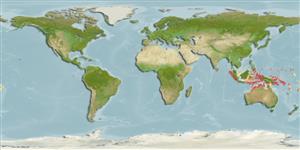>
Gobiiformes (Gobies) >
Gobiidae (Gobies) > Gobiinae
Etymology: Eviota: No etymology given, suggested by Christopher Scharpt: from Latin 'eu' for 'true' and 'iota' for anything very small, in combination 'truly very small' referring to it as being the smallest vertebrate at the time it has benn described by Jenkins (thus, making the suggestion by Scharpt plausible..
Environment: milieu / climate zone / depth range / distribution range
Ecologie
marien rifbewoner; diepte 3 - 20 m (Ref. 90102). Tropical; 8°N - 18°S
Western Pacific: Japan, Palau, Federated States of Micronesia, Guam and Northern Mariana Islands, Vietnam, Indonesia; south to Rowley Shoals in the Timor Sea, Papua New Guinea, and Solomon Islands.
Grootte / Gewicht / Leeftijd
Maturity: Lm ? range ? - ? cm
Max length : 2.1 cm SL mannelijk / geslacht onbekend; (Ref. 1602)
Dorsale stekels (totaal): 7; Dorsale zachte stralen (totaal): 7-9; Anale stekels 1; Anale zachte stralen: 6 - 7. Characterized by dark purplish brown body color with three white spots anteriorly on middle of side; presence of series of small white spots beginning on nape, continuing along base of dorsal fin and ending on dorsal surface of caudal peduncle; caudal fin base with red-edged black spot; iris reddish; first four dorsal spines elongate or filamentous in male; all pectoral rays unbranched; longitudinal scale series 21-23; ctenoid scales, absent on head, nape and pectoral fin base; separated pelvic fins, thin membrane joining bases; well developed fifth pelvic ray, 50-70% length of fourth ray; 3-6 branches of fourth pelvic ray; depth of body 3.6-5.0 in SL (Ref. 90102).
Inhabits silty sheltered reefs (Ref. 1602). Reported to be associated with the mushroom Heliofungia actiniformis (Ref. 91291).
Levenscyclus en paargedrag
Maturiteit | Voortplanting | Paaien | Eieren | Fecunditeit | Larven
Myers, R.F., 1991. Micronesian reef fishes. Second Ed. Coral Graphics, Barrigada, Guam. 298 p. (Ref. 1602)
Status op de Rode Lijst van het IUCN (Ref. 130435)
Gevaar voor de mens
Harmless
Gebruik door de mens
Meer informatie
Lokale namenSynoniemenMetabolismePredatorenEcotoxicologieVoortplantingMaturiteitPaaienPaaiaggregatiesFecunditeitEierenOntwikkeling van de eieren
ReferentiesAquacultuurAquacultuurprofielKweeklijnenGeneticaElectrophoresesErfelijkheidZiektesVerwerkingNutrientsMassaconversie
Tools
Speciale rapporten
Download XML
Internetbronnen
Estimates based on models
Preferred temperature (Ref.
123201): 27.6 - 29.4, mean 28.8 °C (based on 934 cells).
Fylogenetische diversiteitsindex (Ref.
82804): PD
50 = 0.5000 [Uniqueness, from 0.5 = low to 2.0 = high].
Bayesian length-weight: a=0.00708 (0.00333 - 0.01504), b=3.09 (2.92 - 3.26), in cm total length, based on LWR estimates for this (Sub)family-body shape (Ref.
93245).
Trofisch niveau (Ref.
69278): 3.1 ±0.3 se; based on size and trophs of closest relatives
Weerstandsvermogen (Ref.
120179): Hoog, minimale populatieverdubbelingstijd minder dan 15 maanden (Preliminary K or Fecundity.).
Fishing Vulnerability (Ref.
59153): Low vulnerability (10 of 100).
Nutrients (Ref.
124155): Calcium = 472 [191, 1,637] mg/100g; Iron = 1.78 [0.71, 4.27] mg/100g; Protein = 17.5 [15.4, 19.5] %; Omega3 = 0.102 [0.030, 0.331] g/100g; Selenium = 35.4 [8.8, 118.5] μg/100g; VitaminA = 112 [19, 638] μg/100g; Zinc = 5.24 [2.67, 9.17] mg/100g (wet weight);
